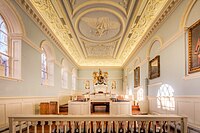Judiciary of Great Nortend
The judiciary of Great Nortend is the branch of the Erbonian government that is responsible for applying the law of Great Nortend. It is administered through His Majesty's Chancery, the Lord High Chancellour.
The Erbonian legal system is constitutionally based in the concept of “natural right”, which is manifested in the customs, precedents and statutes of the nation. The Sovereign as the highest authority in the land, is font of right. The law is applied in the hierarchy of courts which dispense the King's justice.
Law
The intangible “natural right” is the foundation of Erbonian law. All customs, precedents and statutes are seen as the nation's expression of the “natural right” as applicable from time to time. Practically speaking, therefore, there are three main categories of law :— civil law, criminal law and canon law. These are traditionally considered to involve disputes of “Subject against Subject”, “Crown against Subject” and “God against Subject”.
All of these specialised branches of law, such as military law, admiralty law, forest law, mining law, &c., fall into one of these three main categories.
Courts
All Erbonian courts exercise the Sovereign's prerogative, as the font of right, to “do right” to his subjects. There are two types of court :— the sessions courts and the royal courts. The former dispense “low justice” and deal with misdemeanours and civil quarrels between fellow vassals. The latter dispense “high justice” with the sole right to pass a sentence of death. They also deal with disputes between subjects under the jurisdiction of no single sessions court. There is a system of appeal from the lowest sessions court to the highest royal court.
The sessions courts are local courts consisting of the manor sessions, the petty sessions and the general sesssions, which try with disputes within a manor, a hundred and the county at large respectively. They are presided over by lay judges, mainly recorders and yeomen of right. While they apply chamber law, they have no power to create precedents by their judgment. New customary rules can be established over time, although this is quite rare nowadays.
The main Royal courts are the Court of Chancery Chamber, the Court of King's Chamber and the Court of Common Chamber, collectively known as the chamber courts, which deal with mostly canonical, criminal and civil matters respectively. The two secular courts are staffed by trained judges appointed under the Great Seal of the Realm to serve at the Sovereign's pleasure. Their judgments form the body of chamber law which is binding to an extent on themselves and lower courts upon inrolment on their respective chamber rolls. Furthermore, their justices periodically go on Eyre around the kingdom sitting as Courts of Eyre.
Appeals from the chamber courts lie to the Court of Counsellours responding to petitions to the Sovereign himself. In fact, the court is a sitting of Parliament, presenting its verdicts as “billae” to the Crown for assent. There are also specialised courts of Admiralty, of the Marischal and Constable, of Verders, &c. which exercise principally specialised delegated jurisdiction.
Judges
Lords Justices
The Lord Justices are the main justices, or rather suitours, of the Court of Counsellours where they are known as Law Counsellours. Lord Justices are appointed typically from senior chamber justices and are members of the House of Lords, being created knights banneret by the Sovereign. Though they have full voting rights in the House, by custom this is not exercised except in matters of law. The Lord Justice of Common Chamber and Lord Justice of King's Chamber are Lord Justices. The Lord High Chancellour and Lord High Steuard preside over proceedings, but nowadays do not usually vote.
Chamber Justices
The secular chamber courts have a total of twenty-four justices appointed from the ranks of Serjeants at Law (servientes ad legem). There are two Lord Justices—the Lord Justice of Common Chamber and the Lord Justice of King's Chamber—as well as eleven puisne justices each. The Court of Chancery Chamber is presided over by the Lord High Chancellour with six puisne justices.
Dress
On festal occasions and red-letter days, all justices wear scarlet robes lined in fur. The fur of all Lord Justices is ermine, whereas miniver is used for Chancery Chamber puisne justices, grys for the King's Chamber and black sable for the Common Chamber. A hood and mantle is worn with the robe with a black silk girdle around the waist. A detachable collar is worn with white bands or jabot as well as a powdered full-bottomed wig. Gloves and lace cuffs are also worn and the black cap is carried. Court dress is worn underneath the robes.
On normal sitting days, the justices wear scarlet robes in summer and crimson in the winter faced in white, grey or black silk, whether Chancery Chamber, King's Chamber or Common Chamber. This is worn with a casting-hood instead of the full hood. The casting-hood is a hood thrown by the liripipe behind the body, giving the effect of a sash. Justices wear with this 'undress' a short bench wig. Court dress is still worn underneath the robes.
Sessions yeomen justices mostly wear plain black gowns over court dress. General sessions justices, sheriffs, and certain local or county dignitaries wear violet robes trimmed in some sort of silk or fur.
This page is written in Erbonian English, which has its own spelling conventions (colour, travelled, centre, realise, instal, sobre, shew, artefact), and some terms that are used in it may be different or absent from other varieties of English. |



